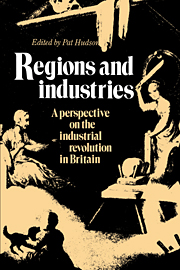Book contents
- Frontmatter
- Contents
- List of figures
- List of maps
- List of tables
- List of contributors
- Acknowledgements
- Introduction
- 1 The regional perspective
- PART ONE THE TEXTILE HEARTLANDS OF THE INDUSTRIAL REVOLUTION
- PART TWO OTHER PATHS, OTHER PATTERNS
- 4 Continuity and change in an industrialising society: the case of the West Midlands industries
- 5 Stages of industrialisation in Cumbria
- 6 The de-industrialisation process: a case study of the Weald, 1600–1850
- 7 Work, culture and resistance to machinery in the West of England woollen industry
- PART THREE THE DIVERSE NATURE OF THE OUTER REGIONS
- Index
6 - The de-industrialisation process: a case study of the Weald, 1600–1850
from PART TWO - OTHER PATHS, OTHER PATTERNS
Published online by Cambridge University Press: 05 May 2010
- Frontmatter
- Contents
- List of figures
- List of maps
- List of tables
- List of contributors
- Acknowledgements
- Introduction
- 1 The regional perspective
- PART ONE THE TEXTILE HEARTLANDS OF THE INDUSTRIAL REVOLUTION
- PART TWO OTHER PATHS, OTHER PATTERNS
- 4 Continuity and change in an industrialising society: the case of the West Midlands industries
- 5 Stages of industrialisation in Cumbria
- 6 The de-industrialisation process: a case study of the Weald, 1600–1850
- 7 Work, culture and resistance to machinery in the West of England woollen industry
- PART THREE THE DIVERSE NATURE OF THE OUTER REGIONS
- Index
Summary
The fact of de-industrialisation in the Weald of Kent, Surrey and Sussex between 1600 and 1850 is well attested. In 1600 the Weald had been the major English producer of glass and iron, especially ordnance. It was also extremely important for its production of timber and timber products and textiles, especially dyed broadcloth. As many as forty-nine out of the total eighty-five English blast furnaces were in the Weald in 1600. Both cloth production and glass reached their peak of output around 1600 and clearly the Weald was one of England's leading industrial areas at this time. This contribution will examine a region which provides a clear example of the failed transition from proto-industrialisation to full industrialisation, and also one in which the place of industry was not taken up by commercial agriculture. What were the processes behind this industrial decline? And why did such a vibrant proto-industrial region of the sixteenth century fail to sustain its early achievements?
PROTO-INDUSTRIALISATION OR UNDERDEVELOPMENT?
Although only industries producing goods which are sold outside the region can truly be said to be proto-industrial, and the manufacture of iron and glass does not fit comfortably into a Mendels-style framework of analysis, the Weald was certainly a proto-industrial region. And the decline of all the region's industries must be examined in order to appreciate the significance of the transformation that occurred.
- Type
- Chapter
- Information
- Regions and IndustriesA Perspective on the Industrial Revolution in Britain, pp. 156 - 174Publisher: Cambridge University PressPrint publication year: 1989
- 2
- Cited by



